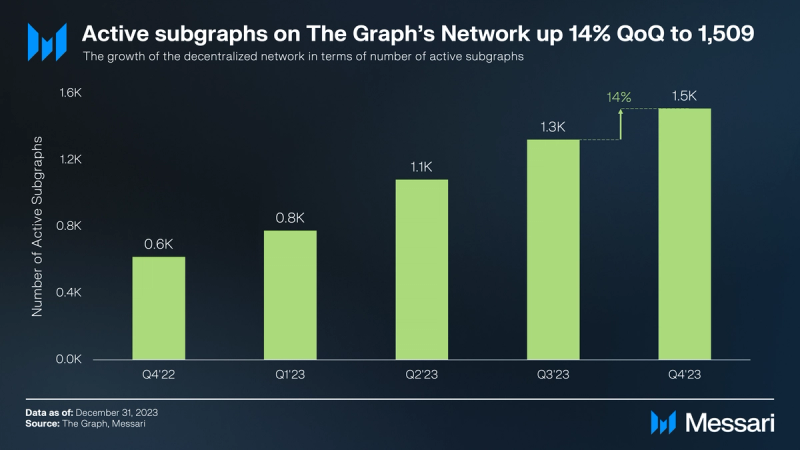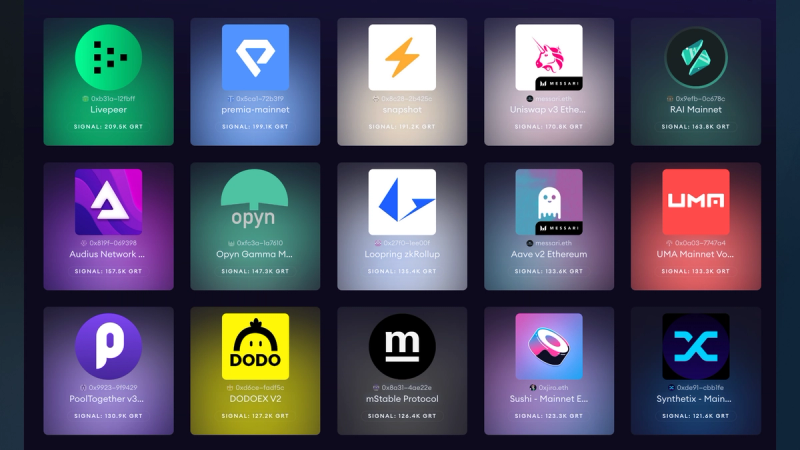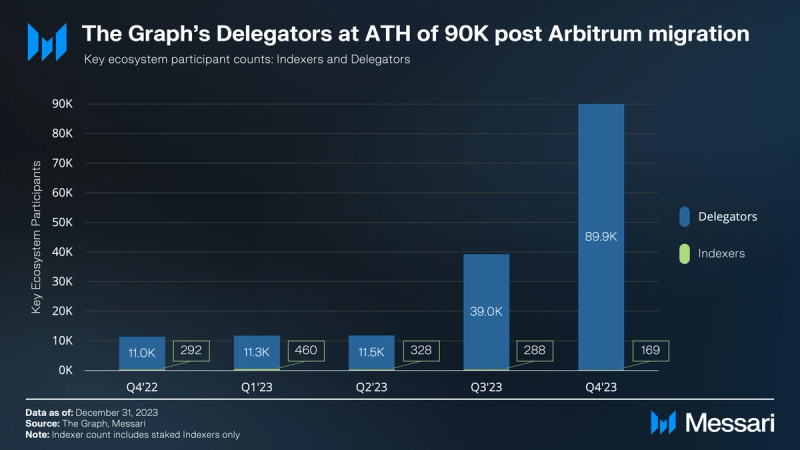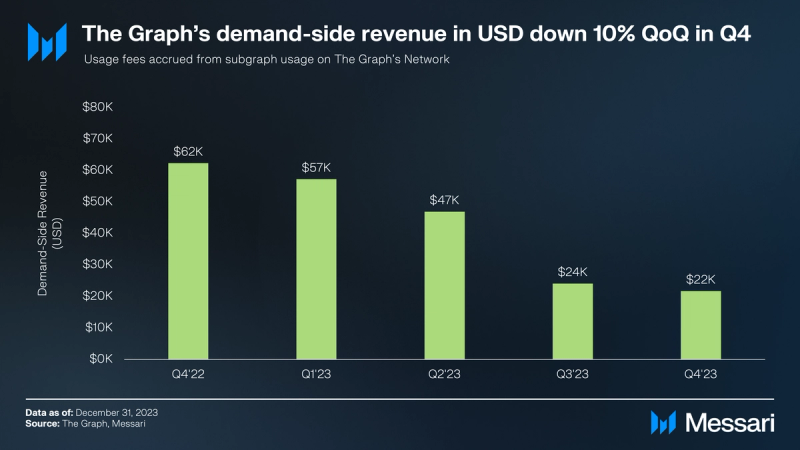Key Insights
- As of Q4’23, 1,509 subgraphs have been published from The Graph’s hosted service to the decentralized network, up 14% QoQ and 144% YoY.
- Indexing rewards decreased by 6% QoQ and 7% YoY in GRT terms, as the GRT annual inflation was below 3% throughout 2023. In USD terms, indexing rewards grew by 24% QoQ to nearly 10 million USD, driven by an increase in GRT/USD exchange rate.
- Demand-side revenue in USD dropped 10% QoQ and 65% YoY, driven by query price optimizations. In GRT terms, demand-side revenue decreased 25% QoQ and 80% YoY.
- The Graph released an upgrade Indexer. It enables developers to upgrade their hosted service subgraphs to The Graph Network (decentralized network) as part of the larger plan for the sunrise of decentralized data.
- The Graph released a roadmap to address data service needs, from improving Indexer tooling to new data services such as SQL, file hosting, and LLMs.
Primer
The Graph is an indexing protocol that provides onchain data — such as DeFi transactions or liquidity pool data — from a wide spectrum of sources. It removes the need for data consumers (e.g., app developers) to build out complicated infrastructure to get onchain data. Instead, data consumers pay to query custom APIs of onchain data — called “subgraphs” — via the GraphQL API. Subgraphs define a data schema to be indexed, making that data queryable. Subgraphs can be developed and queried by anyone.
To ensure the protocol runs correctly and efficiently, The Graph network incentivizes several key roles within its ecosystem of both technical and non-technical participants:
- Indexers process and store onchain data from subgraphs. They usually have advanced technical knowledge to operate nodes. In return, Indexers receive query fees from data consumers and indexing rewards from new token issuance.
- Curators are economically incentivized to analyze and signal which subgraphs are valuable to index. Curators earn a 10% portion of the query fees generated by particular subgraphs.
- Delegators do not employ resources to index onchain data; instead, they delegate The Graph’s native utility token GRT to Indexers. In return, Delegators earn a portion of query fees and indexing rewards without running nodes themselves.
As of Q4’23, The Graph’s decentralized protocol supports seven networks with indexing rewards: Ethereum, Polygon, Arbitrum, Avalanche, Fantom, Optimism, Gnosis Chain, and Celo. The upgrade Indexer supports 25+ other chains and testnets, with indexing rewards pending Chain Integration Process governance approval.
The Graph ecosystem has completed the transition to Arbitrum One (L2) to reduce gas fees and transaction times. Complementing this transition, L2 Transfer Tools are aimed to help all Delegators and Indexers streamline L2 adoption.
Key Metrics
Performance Analysis
The Graph Network is used by dapp developers and data consumers that pay to query subgraph data. The performance of the network can be measured by the growth of active subgraphs, the network’s revenue in query fees, and the activity of the key ecosystem participants: Indexers, Delegators, and Curators.
Usage
Subgraphs
To bootstrap The Graph, a hosted service was initially created. This service hosts subgraphs as the protocol gradually transitions to its decentralized network. The hosted service is free (subsidized by The Graph ecosystem) and consists of indexing infrastructure run by Edge & Node, the initial team behind The Graph.
The first decentralized subgraph launched (on the decentralized network) in Q1’21. As of Q4’23, The Graph is a hybrid of its hosted service and decentralized network.

Over the past five quarters, the number of subgraphs launched on The Graph’s Network has grown steadily. As of December 2023, there are 1,509 active subgraphs on the decentralized network, up 14% QoQ from 1,322 at the end of Q3’23. Unlike the hosted service, The Graph Network requires data consumers to pay a fee per query to Indexers. These query fees are further distributed by Indexers to Delegators and Curators.

Source: The Graph Explorer
The number of deployed subgraphs on The Graph’s Network is expected to continue increasing. The Graph community aims to upgrade all subgraphs from the hosted service to its decentralized network, as more chains integrate with the decentralized network. Simultaneously, the upgrade Indexer enables developers to upgrade their hosted service subgraphs to The Graph Network (decentralized network) as part of the larger plan for the sunrise of decentralized data.
Ecosystem Participation
Subgraphs provide an arena for both technical and non-technical ecosystem participants to interact symbiotically:
- Indexers operate Graph Nodes to process and store onchain data. Data consumers can then query this data via GraphQL, an open-source language for The Graph’s APIs.
- Curators signal to Indexers which subgraphs are worth indexing. Curators also often act as subgraph developers.
- Delegators are ecosystem participants who may lack the technical know-how or resources to index; they may choose to delegate GRT to Indexers.
Staked GRT is required for indexing subgraphs. As Indexers receive more GRT via delegation, they increase their capacity to index a larger number of subgraphs on the network. Indexers monetize their indexing and query processing services on The Graph’s query market by staking GRT.
The minimum stake for an Indexer is currently set to 100,000 GRT (almost $19,000 as of December 31, 2023). On top of this minimum, Indexers can also receive delegated stake from other ecosystem participants. Delegators can increase their total stake up to 16x an Indexer’s personal stake.

Driven by a Coinbase Earn campaign, the number of Delegators jumped 131% QoQ to nearly 90,000 in Q4’23, after growing 240% QoQ in Q3’23 as well. Simultaneously, Indexers actively staking GRT decreased 41% to 169 at the end of Q4’23 from its peak of 460 staked Indexers at the end of Q1’23. This continuous decrease in staked Indexers can be attributed to the conclusion of The Graph’s Multi-Chain Incentivized Program at the end of Q1’23 as well as to some Indexers simultaneously un-staking their GRT. This behavior hints at the potential dependency of Indexers on reward incentives as they seek to balance operating costs with revenue accrued from staking GRT and servicing queries on The Graph’s decentralized network.
Revenue
The GRT token follows the Stake-for-Access model, also known as a utility token model. Participants in The Graph’s ecosystem earn revenue in GRT by performing work in the form of indexing and querying services on the decentralized network. Both services require GRT to be staked. Indexers’ stake comprises their own GRT tokens (i.e., self-stake) and GRT delegated toward them (i.e., delegated stake).
The two main sources of revenue for Indexers are indexing rewards and query fees paid by data consumers. Revenue from both indexing rewards and query fees is funneled through Indexers who then distribute it to Delegators and Curators.
Every Indexer is free to define their own individual cut of query fees and indexing rewards, based on the supply-and-demand dynamics of the open marketplace. According to this individual cut, each Indexer then distributes the indexing rewards and query fees with Delegators, whereas the Curators earn a 10% portion of the query fees generated by particular subgraphs.

Source: The Graph: Choosing Indexers
As per the above example, if an Indexer sets the query fee cut to 13.96%, their Delegators would receive the remaining 86.04% of the fee revenue proportional to their stake. While Delegator stake cannot be slashed, Delegators should still consider several factors when staking GRT with Indexers. These factors relate to:
- Indexer choice, i.e., choosing effective Indexers with the most optimal balance between reward payouts and “skin-in-the-game” from allocation of self-stake.
- Unbonding period, i.e., no GRT transfers or rewards are possible within a 28-day window after un-delegation.
- Delegation tax of 0.5%, i.e., calculating how long it takes to earn back the 0.5% tax on delegation.
Indexing Rewards
Indexing rewards come from a GRT annual inflation below 3%, derived from the GRT issuance rate. Rewards are distributed to staked Indexers in return for providing indexing and querying services on The Graph’s open marketplace.

Indexing rewards increased 24% QoQ to almost $10 million in Q4’23, mainly driven by the appreciation in the USD price of the GRT token. In GRT terms, indexing rewards decreased 6% QoQ from 79.6 million GRT in Q3’23 to 74.6 million GRT in Q4’23. This decrease in the issuance of indexing rewards is a consequence of the governance decision to set the protocol issuance rate to The Graph’s original 3% prior to The Merge in September 2022.
For context, the number of blocks created on Ethereum increased following The Merge. As a result, the GRT rewards issued per block increased to 3.2% for approximately one month in Q4’22. The increase led the overall quarterly rewards to exceed 80 million GRT ($6.0 million). Following Q4’22, quarterly indexing rewards stayed below the 80 million GRT mark.
Query Fees (Network Usage Fees)
While the bulk of Indexer earnings come from rewards, the second source of revenue on The Graph Network is query fees (demand-side revenue). Data consumers (e.g., app developers) pay query fees for Indexers to fetch and organize data. As of Q4’23, The Graph delivers data to projects like Polygon, Art Blocks, and Loopring.
Query fees are determined by market demand and distributed to Curators, Indexers, and Delegators.

Total revenue from query fees decreased 10% QoQ in USD terms, after reaching an all-time high in Q1’23. This decrease in demand-side revenue in USD has been primarily driven by optimizations in query pricing.
For The Graph, the Q4’23 total revenue from query fees (over $22,000) made up 0.2% of the total revenue from indexing rewards (approximately $9.9 million). This distribution indicates that The Graph’s network participants still strongly rely on indexing rewards for sustaining their day-to-day operations.
Qualitative Analysis
Releases
Optimism Live on The Graph Network
The Graph Network added full support for Optimism and Substreams-powered subgraphs (SPS). The new Chain Integration Process (CIP) enables indexing rewards for Optimism subgraphs and Substreams-powered subgraphs. These integrations enhance the protocol’s capabilities, with subsequent updates to the official documentation and support matrix upon The Graph Council’s approval. Simultaneously, there are preliminary discussions on adding support for Astar zkEVM, Kava Mainnet, BEVM Canary, and opBNB.
New Subgraph Features
This successful proposal updated the previously ratified Feature Support Matrix for Graph Node V0.33.0. The graph-node V0.33.0 update introduces a list of new features, including Arweave file data sources, a performance boost for Substreams-powered subgraphs (SPS), a polling block handler filter, DataSourceContext in the manifest, various bug fixes, and other minor changes.
Upgrade Indexer
A core developer team on The Graph, Edge & Node, announced its “upgrade Indexer,” a mechanism aimed to simplify upgrading subgraphs from the hosted service. The proposed solution would ensure that there is an Indexer ready to serve queries right after a subgraph is published to the network. Furthermore, the upgrade Indexer will allow subgraph developers to publish hosted service subgraphs to The Graph Network gas-free, and it will deliver pre-synced subgraphs for immediate use.
The upgrade Indexer will not earn any indexing rewards; instead, it is designed to only earn “minimally viable query fees.” All Indexers will be able to participate as upgrade indexers in a permissionless manner.
Substreams.dev
The Substreams.dev platform by core developer StreamingFast aims to assist developers with their Substreams experience in an environment similar to other package management solutions. The platform aims to be the main hub for all Substreams development.
Key Decisions
Increase L2 rewards to 95% (GIP-0033)
This successful proposal increased L2 rewards to 95% of total issuance (i.e., ~115 GRT per block) on Arbitrum One on November 27, 2023. Simultaneously, it reduced L1 issuance to 5% (i.e., ~6 GRT per block) and adjusted the L1 bridge mint allowance accordingly.
Optimize Query Fees to Indexers (GIP-0063)
This proposal aims to remove the currently ineffective incentive (11% of query fees) for third-party Curators and instead redirect those incentives to Indexers. The proposed solution is to remove the routing 10% of query fee cuts from the curation pool to Indexers and to burn 1% of query fees. While curation was originally designed to incentivize independent third parties to identify “valuable” subgraphs, curation has worked largely as “self-signaling”, thus not fulfilling its purpose. This change would only be applied to the protocol on Arbitrum. Simultaneously:
- GGP-0034 removed the limitation of specific governance-approved entities to pay query fees to Indexers in the network;
- GGP-0035 removed the delegation parameter’s cooldown feature that defines how long an Indexer must wait before setting the delegation query fee and rewards cut.
Simultaneously, the proposal suggests the need for future research into alternative curation mechanisms for The Graph protocol.
Community
Updated Plan for the Sunrise of Decentralized Data
In December 2023, The Graph team began the first phase of the Sunrise of Decentralized Data. Core developers are currently developing an upgrade interface to assist other networks in upgrading hosted service subgraphs to The Graph network.
The plan to enable prospective users to more easily upgrade to The Graph Network is composed of three phases:
- Sunray phase: enable support for all hosted service chains via the upgrade Indexer; introduce an easy upgrade flow to help hosted service users upgrade subgraphs to The Graph Network; offer a free query plan on The Graph Network.
- Sunbeam phase: introduce a 60-day upgrade window to upgrade hosted service subgraphs, with dedicated upgrade support.
- Sunrise phase: hosted service endpoints will be retired as all subgraphs upgrade to The Graph Network.
Subgraph Developer Experience
This preliminary discussion requests $40,675 to fund OpenUX to complete user research on the experiences of developers who are new to subgraphs, developers who have recently begun creating and maintaining their own subgraphs, and developers who are already familiar with subgraph APIs.
BuildersDAO and InfraDAO Support
Two DAOs have ramped up operations in The Graph ecosystem. BuildersDAO’s objective centers around subgraphs and Substreams, with the DAO supporting developers who actively use or develop new subgraphs and Substreams. BuildersDAO also boasts an educational arm creating content for best development practices across various data services on The Graph.
InfraDAO aims to provide R&D, tooling, and documentation for The Graph ecosystem. In addition, InfraDAO also specializes in Chain Integration Process (CIP) Tooling, empowering new chains to integrate with The Graph Network and later become eligible for indexing rewards.
New Core Devs: Pinax & Geo
Pinax aims to enhance The Graph Network. Focusing primarily on Firehose and Substreams. Pinax supports the adoption and scalability of these technologies with tools and libraries, supporting new chains, and educating new users of The Graph with various forms of content and community participation. Geo is a web3 browser and knowledge graph built on The Graph. The team behind Geo is on a mission to organize the world’s public knowledge and information.
Roadmap: New Era of The Graph
The Graph Foundation shared details about its new roadmap (called New Era) and its five core objectives to address data service needs. Each objective supports milestones to drive R&D and the ecosystem’s growth:
- World of Data Services: Deliver a market of data services on the network.
- Developer Empowerment: Support developers through enhanced DevEx and tooling.
- Protocol Evolution & Resiliency: Deliver protocol improvements.
- Optimized Indexer Performance: Boost network performance through Indexer tooling.
- Interconnected Graph of Data: Create tools for composable data and knowledge graphs.
This updated roadmap aims to accommodate use cases including verifiable data, new query languages, and support for LLMs, while serving builders using The Graph.
Closing Summary
Throughout 2023, The Graph Network integrated seven networks and released the upgrade Indexer to support the upgrade of all subgraphs. Simultaneously, The Graph ecosystem completed the transition to Arbitrum One (L2) to reduce gas fees and transaction times.
As of December 2023, The Graph began the first phase of the sunrise of decentralized data. The protocol also released a roadmap to address data service needs, from improving Indexer tooling to leveraging AI and LLMs for streamlined data interaction.
In Q4 2023, Revenue from indexing rewards grew by 24% QoQ and 65% YoY to nearly 10 million USD. In GRT, indexing rewards decreased by 6% QoQ and 7% YoY. Demand-side revenue in USD dropped 10% QoQ and 65% YoY, primarily driven by query price optimizations. In GRT, demand-side revenue decreased 25% QoQ and 80% YoY.
Since Q1’21, The Graph has been focused on the migration from a hosted service to a decentralized network. As of Q4’23, 1,509 subgraphs have been published from The Graph’s hosted service to the decentralized network, up 14% QoQ. As more subgraphs are migrated to the decentralized network in the coming quarters, The Graph will continue to remove technical barriers for developers, ultimately leading to faster innovation across the entire crypto space.




















